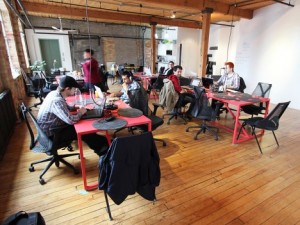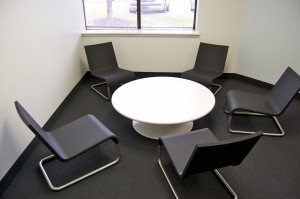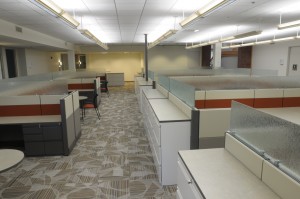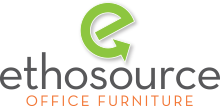 The recent open office trend has certainly become a popular modern office design in the past couple of years. But not everyone has been jumping on the bandwagon in the quite same way. Many have countered the new trend with various reasons as to why the elimination of private offices and cubicles isn’t as beneficial to employee productivity and creativity as people want to think. It may look pretty cool, but it doesn’t necessarily mean your employees’ best work will come from it. For many companies, they’re facing the battle of collaboration vs. privacy and aesthetics vs. functionality.
The recent open office trend has certainly become a popular modern office design in the past couple of years. But not everyone has been jumping on the bandwagon in the quite same way. Many have countered the new trend with various reasons as to why the elimination of private offices and cubicles isn’t as beneficial to employee productivity and creativity as people want to think. It may look pretty cool, but it doesn’t necessarily mean your employees’ best work will come from it. For many companies, they’re facing the battle of collaboration vs. privacy and aesthetics vs. functionality.
One of the companies that have resisted the temptation to switch to an open office layout is Microsoft. Their design, instead, gives employees the ability to work within their own private office, and when they need to collaborate, they simply open their doors and slide their chairs back into the hallway area to meet. For this reason, this area has been dubbed the “hallway of knowledge.” It’s a unique set up, but the reason behind it stems from a not-so-uncommon belief: too much collaboration isn’t a good thing.
The modern open office helps achieve all the necessary aspects of a collaborative and social work environment, but in return, eliminates the ability to block out surrounding noise and distractions. Despite the irony in the name, many are getting frustrated with the crowded-feel of the open-office. It’s one thing to share thoughts and ideas with coworkers, but it’s another to share your actual space. For those of us spending 9+ hours a day at work, there comes a time when the ability to gather your own thoughts and concentrate is a crucial part of the day. Many knowledge workers spend more than half of their day on work that requires high-focus. Without the option to get some peace and quiet, these workers’ performances will likely suffer.
According to one study by a global design firm, Gensler, 2/3 of US employees are unhappy with the noise levels at work, therefore finding it hard to concentrate.
As an office furniture company with in-house professional design services, EthoSource has had customers with requests for all types of office layouts, and we consider it our job to help create the best customized set up for each business. While every customer is different, we are often faced with the same question, “how do we create an environment conducive to collaboration that doesn’t sacrifice the need for privacy and hurt employee productivity?” The solution: finding the right balance.
Since 2008, employee workplace performance is said to have dropped 6%, largely due to the inability to concentrate due to distractions that surround us. But there are certainly notable reasons as to why companies as as whole have moved away from the layouts that have once isolated employees from one another completely. Neither an overly shared workspace, nor a fully-private office is going to meet the needs of modern work styles. The compromise is incorporating both designs into the workspace, so that employees are given the opportunity to chose based on the task or situation at hand.
 Many offices are finding the solution through small “focus booths” or “huddle rooms” that serve as a quiet space for an individual or a small, creative meeting area for a couple of coworkers. While offices are grouping employees in the open layout by department or team, they are then designating various rooms for individual work, private phone calls, or special meetings. The changing open office designs are now being created to group employees into team areas based on their related work needs, while keeping them separated from the high-traffic passways and other teams. The goal of this style is to minimize visual and casual distractions that occur in those areas.
Many offices are finding the solution through small “focus booths” or “huddle rooms” that serve as a quiet space for an individual or a small, creative meeting area for a couple of coworkers. While offices are grouping employees in the open layout by department or team, they are then designating various rooms for individual work, private phone calls, or special meetings. The changing open office designs are now being created to group employees into team areas based on their related work needs, while keeping them separated from the high-traffic passways and other teams. The goal of this style is to minimize visual and casual distractions that occur in those areas.
Some companies have begun utilizing this system, and design their “quiet rooms” to include sofas and plenty of room to stretch and meditate. Other options for these rooms include a simple work table and chairs or standing desks, benches, lounge chairs and other types of furniture to create a flexible and relaxed environment. In terms of sharing these different rooms, experts have recommended allotting some rooms to be reservation only, while others are utilized on a first come, first served basis.
A variety of companies across different industries have employed the open office design only to be met by employee resistance. Some companies have even gone as far as to have a “free address” workplace, where employees aren’t even assigned a specific station or seat to call their own. Employees must find open real estate to call their own for the day (or afternoon or hour), and it changes daily. The one plus side is having the ability to remove yourself from a specific noisy area (or employee) at any time, but the negatives of this layout seem to tip the scale. A number of attempts at this “free address” design eventually required companies to add various focus rooms as the layout was unable to meet the specific privacy needs of certain employees, therefore preventing them from performing their best.
 Not all companies will experience the same negatives of a fully collaborative work environment, but there have been restrictions to the design that have altered the way people approach an open office design. Looking for ways to incorporate the best of both styles have really encouraged workplace designers to get creative with their client’s workspace, but have led to some of our most productive work environments yet. It’s no surprise as to why the modern workplace is always changing, but it’s unlikely that the companies that have already invested a good deal into the newest workplace trends will make too many drastic changes to resort back to more privacy. That’s why understanding your employees’ needs is a crucial step in the office design process, as well as having a knowledgable and professional design team to help you each step of the way.
Not all companies will experience the same negatives of a fully collaborative work environment, but there have been restrictions to the design that have altered the way people approach an open office design. Looking for ways to incorporate the best of both styles have really encouraged workplace designers to get creative with their client’s workspace, but have led to some of our most productive work environments yet. It’s no surprise as to why the modern workplace is always changing, but it’s unlikely that the companies that have already invested a good deal into the newest workplace trends will make too many drastic changes to resort back to more privacy. That’s why understanding your employees’ needs is a crucial step in the office design process, as well as having a knowledgable and professional design team to help you each step of the way.
So… is your company’s workplace in need of a change?
If you’re looking to switch up your office furniture or layout, but aren’t quite sure what’s the next step, send us a project inquiry, and we’ll help you get started. It’s time to get the modern office your company needs!
Resources:
Open-Office Victims Push Back by Ronald Alsop, BBC Capital, September 12 2014
